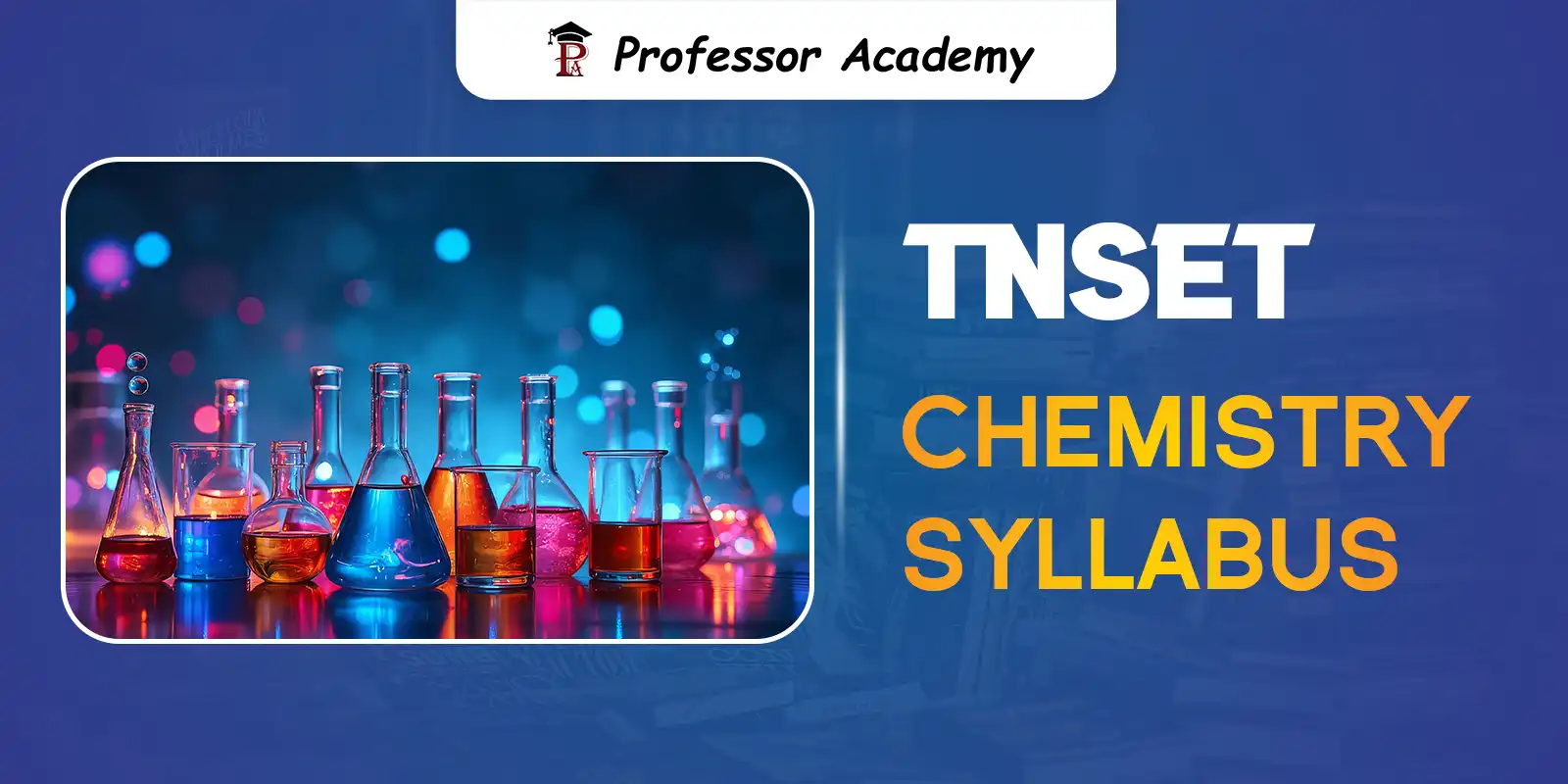TNSET Chemistry Syllabus

Get a molecular-level grasp of the subject with the TNSET Chemistry syllabus, featuring Organic, Inorganic, Physical Chemistry, Analytical Chemistry, and Spectroscopy.
With Professor Academy’s topic-wise coaching, you’ll prepare smarter for success.
Explore the full TNSET Chemistry syllabus and begin your preparation today.
TNSET Chemistry Syllabus
Inorganic Chemistry
- Chemical periodicity
- Structure and bonding in homo- and heteronuclear molecules, including shapes of molecules (VSEPR Theory).
- Concepts of acids and bases, Hard-Soft acid base concept, Non-aqueous solvents.
- Main group elements and their compounds: Allotropy, synthesis, structure and bonding, industrial importance of the compounds.
- Transition elements and coordination compounds: structure, bonding theories, spectral and magnetic properties, reaction mechanisms.
- Inner transition elements: spectral and magnetic properties, redox chemistry, analytical applications.
- Organometallic compounds: synthesis, bonding and structure, and reactivity. Organometallics in homogeneous catalysis.
- Cages and metal clusters.
- Analytical chemistry- separation, spectroscopic, electro- and thermoanalytical methods.
- Bioinorganic chemistry: photosystems, porphyrins, metalloenzymes, oxygen, transport, electron- transfer reactions; nitrogen fixation, metal complexes in medicine.
- Characterisation of inorganic compounds by IR, Raman, NMR, EPR, Mössbauer, UV- vis, NQR, MS, electron spectroscopy and microscopic techniques.
- Nuclear chemistry: nuclear reactions, fission and fusion, radio-analytical techniques and activation analysis.
Physical Chemistry
- Basic principles of quantum mechanics: Postulates; operator algebra; exactly solvable systems: particle-in-a-box, harmonic oscillator and the hydrogen atom, including shapes of atomic orbitals; orbital and spin angular momenta; tunneling.
- Approximate methods of quantum mechanics: Variational principle; perturbation theory up to second order in energy; applications.
- Atomic structure and spectroscopy; term symbols; many-electron systems and antisymmetry principle.
- Chemical bonding in diatomics; elementary concepts of MO and VB theories; Huckel theory for conjugated pi-electron systems.
- Chemical applications of group theory; symmetry elements; point groups; character tables; selection rules.
- Molecular spectroscopy: Rotational and vibrational spectra of diatomic molecules; electronic spectra; IR and Raman activities – selection rules; basic principles of magnetic resonance.
- Chemical thermodynamics: Laws, state and path functions and their applications; thermodynamic description of various types of processes; Maxwell’s relations; spontaneity and equilibria; temperature and pressure dependence of thermodynamic quantities; Le Chatelier principle; elementary description of phase transitions; phase, equilibria and phase rule; thermodynamics of ideal and non-ideal gases, and solutions.
- Statistical thermodynamics: Boltzmann distribution; kinetic theory of gases; partition, functions and their relation to thermodynamic quantities – calculations for model systems.
- Electrochemistry: Nernst equation, redox systems, electrochemical cells; DebyeHuckel theory; electrolytic conductance – Kohlrausch’s law and its applications; ionic equilibria; conductometric and potentiometric titrations.
- Chemical kinetics: Empirical rate laws and temperature dependence; complex reactions; steady state approximation; determination of reaction mechanisms; collision and transition state theories of rate constants; unimolecular reactions; enzyme kinetics; salt effects; homogeneous catalysis; photochemical reactions.
- Colloids and surfaces: Stability and properties of colloids; isotherms and surface area; heterogeneous catalysis.
- Solid state: Crystal structures; Bragg’s law and applications; band structure of solids.
- Polymer chemistry: Molar masses; kinetics of polymerization.
- Data analysis: Mean and standard deviation; absolute and relative errors; linear regression; covariance and correlation coefficient.
Organic Chemistry
- IUPAC nomenclature of organic molecules including regio- and stereoisomers.
- Principles of stereochemistry: Configurational and conformational isomerism in acyclic and cyclic compounds; stereogenicity, stereoselectivity, enantioselectivity, diastereoselectivity and asymmetric induction.
- Aromaticity: Benzenoid and non-benzenoid compounds – generation and reactions.
- Organic reactive intermediates: Generation, stability and reactivity of carbocations, carbanions, free radicals, carbenes, benzynes and nitrenes.
- Organic reaction mechanisms involving addition, elimination and substitution reactions with electrophilic, nucleophilic or radical species. Determination of reaction pathways.
- Common named reactions and rearrangements – applications in organic synthesis.
- Organic transformations and reagents: Functional group interconversion including oxidations and reductions; common catalysts and reagents (organic, inorganic, organometallic and enzymatic). Chemo, regio and stereoselective transformations.
- Concepts in organic synthesis: Retrosynthesis, disconnection, synthons, linear and convergent synthesis, umpolung of reactivity and protecting groups.
- Asymmetric synthesis: Chiral auxiliaries, methods of asymmetric induction substrate, reagent and catalyst controlled reactions; determination of enantiomeric and diastereomeric excess; enantio-discrimination. Resolution – optical and kinetic.
- Pericyclic reactions – electrocyclisation, cycloaddition, sigmatropic rearrangements and other related concerted reactions. Principles and applications of photochemical reactions in organic chemistry.
- Synthesis and reactivity of common heterocyclic compounds containing one or two heteroatoms (O, N, S).
- Chemistry of natural products: Carbohydrates, proteins and peptides, fatty acids, nucleic acids, terpenes, steroids and alkaloids. Biogenesis of terpenoids and alkaloids.
- Structure determination of organic compounds by IR, UV-Vis, 1 H & 13 C NMR and Mass spectroscopic techniques.
Interdisciplinary topics
- Chemistry in nanoscience and technology.
- Catalysis and green chemistry.
- Medicinal chemistry.
- Supramolecular chemistry.
- Environmental chemistry.
Download TNSET Chemistry Syllabus
Enrol Now At
Website: https://professoracademy.com/courses/tnset-chemistry/
Email: enquiry@professoracademy.com
Contact: +91 7070701005 / +91 7070701009


